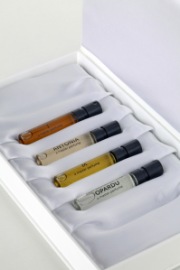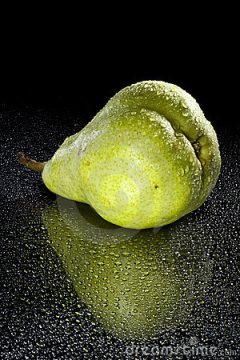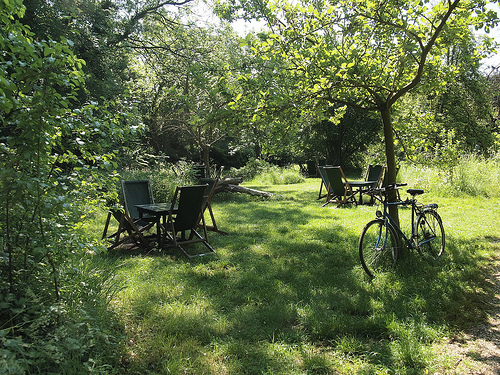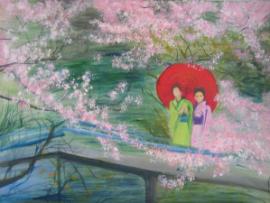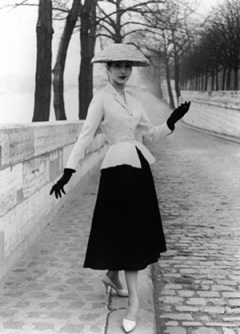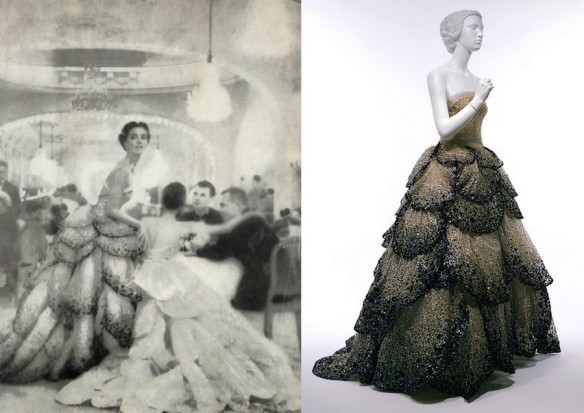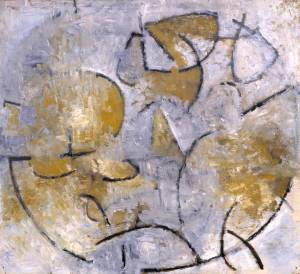A woman walks through the mist and fog in her small private garden in London. It’s the 1930s, and she wears a long, evening gown with ropes of pearls for the dinner party that she’ll attend later at Grosvenor Square. She is half visible, half hidden in the swirls of the fog; a soft shimmer of a figure, she almost seems like a mirage. Spring flowers surround her, wet and sweet, but there is mostly green in the air from verdant bushes behind her and the climbing ivy that trails the walls of the nearby house.

Photo by Sheila Rock, “Garden Mist,” 2012. Source: Photography-now.com exhibitions.
http://photography-now.com/exhibition/details/89795
That’s the vision that comes to mind when I wear Antonia by the luxury, niche perfume house, Puredistance. It is an elegant, feminine, green floral perfume with an old-fashioned, sophisticated feel done in a very modern, light, airy manner. It is not my favorite from the perfume house (which actually is one of my favorites brands), but that is only because I’m not really a green perfume sort of person. Antonia is a beautiful scent that will definitely appeal to those who love sophisticated, timeless fragrances with these particular set of notes.
 Antonia was released in 2010, the creation of Master Perfumer, Annie Buzantian. Like all of Puredistance’s fragrances, it is an extrait de parfum, the very highest concentration possible. In the particular case of Antonia, it clocks in at 25% perfume oil, which is very high indeed, though it is not Puredistance’s richest. (That would be the stunning Opardu.) The company describes the scent as follows:
Antonia was released in 2010, the creation of Master Perfumer, Annie Buzantian. Like all of Puredistance’s fragrances, it is an extrait de parfum, the very highest concentration possible. In the particular case of Antonia, it clocks in at 25% perfume oil, which is very high indeed, though it is not Puredistance’s richest. (That would be the stunning Opardu.) The company describes the scent as follows:
Antonia… is a green floral with a great lushness and warmth of heart, but at the same time pillowy and gentle as can be. Key in the creation of Antonia is the image of a strong, positive, but at the same time gentle woman. […¶]
The Perfume is neither modern, nor old-fashioned – Antonia is a timeless Perfume with a feel of innocence, yet feminine and confident. She grabs you with gentleness and faithfully stays with you, tenacious, but never overwhelming. She dances with graceful ease in a harmonious balance struck between the crisp, verdant optimism of galbanum top notes and the smooth, creamy sensuality of vanilla in the dry-down.
Ingredients: Jasmine, Rose Essence, Ylang Ylang, Orris [iris], Ivy green, Galbanum, Vanilla, Vetiver.
Galbanum, for those who may not know, is a gum resin from certain Persian plants which resemble large fennel or anise plants. Its smell is very green, often bitter or pungent, sometimes herbal or grass-like, but almost always with a woody undertone.
Here, it is a key part of Antonia which opens on my skin with a burst of green and white. There is galbanum but, also, aldehydes which create a soapy film over the green, softening its usual biting, bracing, pungent characteristics, while also adding a certain fizzy quality to the overall notes. Soft florals are intertwined, creating sweetness that further tames the galbanum note. At the same time, there is a hint of rooty, slightly earthy vetiver. The overall impression, however, is of extremely expensive French soap with rose, iris, green notes and vetiver, all intertwined with galbanum.
There is a certain chilly coolness to the elegance. While Puredistance’s founder, Jan Ewoud Vos, feels the perfume evokes his mother (whose name is Antonia), to me, it conjures up a beautiful, slightly haughty, aristocratic European socialite from the early part of the 20th century, languidly lounging in a stunning dress. Iris notes always create that image in my mind but, here, it is also the fact that galbanum was a key staple of more classique fragrances and is not frequently used today. Yet, Antonia is not an old-fashioned scent. It’s definitely a modern twist on the old classic notes; it’s lighter, airier, without bullying powder, or a heavy base. And, for all that I keep seeing aristocratic British socialites in my head, I also keep seeing beautiful gardens in the Spring, full of sweet-smelling white flowers and lush softness.

Aiken House & Gardens. Photo by Carolyn Aiken. Source: http://warrengrovegarden.blogspot.com/2011/08/misty-morn-in-garden.html
As the moments tick by, Antonia becomes sweeter and more floral. The soapy aldehydes retreat more and more, while the jasmine blooms. Very subtle touches of rose and iris trickle up to the surface, along with what feels like hyacinth and lilacs. Neither of those last two flowers are in Antonia, but it feels like it with the very sweet, sometimes purple, feel of airy delicacy. In my mind, the aldehydes are almost like a sheer mist, wafting over a garden in bloom, letting them peek out here or there, but also delicately covering them like a gauzy veil.
Forty-five minutes in, the jasmine becomes much stronger, but it’s never indolic or heavy. Rather, it’s fresh, bright and sparkling — which makes me think that Antonia has hedione in it. For one thing, hedione has long been a key part of 20th century perfumery, especially for French perfumes. While it is often used in place of jasmine absolute, hedione is also sometimes used for its own characteristics in order to create a bright, green, lemon-nuanced fizzy note. For another, hedione is also a frequent partner to jasmine absolute (such as there is in Antonia), when the perfumer is trying to prevent the note from turning indolic and to keep it bright. Here, the jasmine note is very fresh, airy and almost green — the way it would be if hedione were used.
For all the lightweight textural feel to Antonia, the florals are both strong in projection in that first hour and soft in nature, almost like very pillowy cloud floating around you. Yet, the sillage soon drops and, shortly after the first hour, Antonia turns into a skin scent on me. It is the exact same situation that occurred when I tested Puredistance’s Opardu, which was one of the most spectacular florals I’ve tried in years. I don’t know if it was the sharp drop in projection which made the perfume notes harder to detect, or if Antonia is intended to turn into an abstract floral, but for the next three remaining hours, the notes are amorphous, light florals along with mossy galbanum, sometimes peppery green notes, a touch of soap and the merest suggestion of light musk. At times, the ylang-ylang becomes a little more prominent; at other times, it’s a combination of jasmine with ylang-ylang — but for the most part, the flowers bloom together as a well-blended, harmonious whole.
Then, at the start of the sixth hour, Antonia changes. The most prominent note is smooth, lush, creamy vanilla, followed by surprisingly spicy green element (the ivy?), custardy ylang-ylang, and a drop of vetiver. Antonia remains that way for a few more hours, softening even further, then turning into a soft, powdery vanilla in its final dry-down. Its caress finally fades away after the start of the 11th hour which is quite a long period of time on my crazy, perfume-consuming skin.
As I said at the start, Antonia is a very pretty perfume, but it wasn’t my favorite out of the three Puredistance fragrances that I’ve tested thus far. For one thing, I’m not the hugest fan of galbanum, which is a solid thread in the perfume for a good portion of its first six hours, and I don’t go gaga for green fragrances. For another, I’m one of those very odd people who does not like strong aldehydes. It puts me solidly in the minority of perfumistas, I know, but I’ve had issues with aldehydes since I was 7 years old and was given a bottle of Van Cleef & Arpel‘s famous First. When I shuddered over that, I was given Hermès’ Caleche — and that almost put me off perfume altogether, until I was saved by YSL‘s Opium. Soapy aldehydes are, in fact, the very reason why I cannot stand Chanel No. 5 — a confession that I know will make me a pariah amongst perfume bloggers. But I’m telling you all this as a context for Antonia. It’s a fantastic scent with undeniable quality and beauty; I’m simply not in the target audience.
Antonia is very loved in the perfume community and justly so, I think. Perhaps the most instructive, helpful review comes from a blogger who also struggles with galbanum and green fragrances, but who adored Antonia nonetheless. The very talented Candy Perfume Boy wrote, in part, in his lovely review:
What is startling about Antonia is how the strength of the galbanum and floral notes seems to be perfectly weighted so that everything can come through and show its own distinct character, no single part takes centre stage. Annie Buzantian seems to have a real nack for creating a perfect equilibrium within a composition.
Antonia becomes much softer and more powdery with time, she also keeps warming until she moves from being sparkling and exuberant to being cosy and comforting. Dry vanilla and amber create a cosy, maternal aura that surrounds the sweet florals and green galbanum. It’s amazing that a perfume can be so classy, yet so cuddly.
Antonia is a perfume of contrasts, at times she can feel old fashioned (thanks to the strong galbanum and aldehydes) and at others she feels completely contemporary. There is also nothing quite like Antonia available at the moment, she feels like a proper ‘perfume’, a signature scent that encourages loyalty from those who wear her.
The link between Antonia and Jan Ewoud Vos’s mother is very touching and it resonates so well because Antonia feels incredibly maternal. There is something wonderfully comforting about Antonia, her presence is reassuring and loving, like a hug from Mum. She strikes me as a fragrance that could be passed down from mother to daughter through the generations. She is timeless enough to be worn by Grandmother, Mother and Daughter simultaneously. To put it simply; Antonia is liquid emotion.
It’s a beautiful review that definitely captures one side to the perfume. (I still see willowy, 1930s British socialites!) But it is a review that, I hope, will tempt you to try the perfume because there aren’t a lot of things out there that consistently have Puredistance’s trademark elegance.
Antonia is currently part of Puredistance’s “Scent of the Season” promotional special. Until April 30th, 2013, it is available at the same prices as Luckyscent but with many extras added on top for free, as well as free shipping to the U.S. or to an E.U. nation:
- 17.5ml Perfume Spray + leather holder free of charge + plus the Gift Set of all 4 fragrances in 2 ml vials in a satin pouch free of charge for $198 or €165;
- the 2 oz/60ml Perfume bottle + the Gift Set of all four Puredistance fragrances in 2ml vials in a satin-lined box free of charge for $330 or €275; or
- the large 100ml/ 3.4 oz Perfume Flacon + 17.5ml Perfume Spray free of charge: $590 or €490.
Puredistance is one of my favorite houses because their fragrances ooze sophistication, luxuriousness, quality, and the very best of the classique, haute perfume tradition. Each one is stunning in its own way and there is something for everyone, regardless of personal tastes. Their M is a magnificent Chypre-Oriental-Leather-Amber and amongst my favorite perfumes (as well as now being a family favorite as well), while Opardu is perhaps the most beautiful floral I’ve tried in years. Antonia is just as lovely in its own way. If you’re looking for a perfect Spring floral and like soft green scents, I hope you will give it a try.
DISCLOSURE: MY SMALL VIAL WAS PROVIDED COURTESY OF PUREDISTANCE. AS ALWAYS, I MAKE IT VERY CLEAR TO ANY COMPANY WHO SENDS ME THINGS, UPFRONT, THAT THERE IS NO GUARANTEE OF A POSITIVE REVIEW, OR EVEN OF A REVIEW AT ALL. I ALSO MAKE IT CLEAR THAT I WILL ALWAYS BE COMPLETELY HONEST ABOUT A PERFUME, AS MY FIRST OBLIGATION IS TO MY READERS.
DETAILS:
Cost & Availability: Antonia is an extrait de parfum concentration (the highest), and is available in a variety of different sizes and forms on the Puredistance website. The usual retail prices are as follows: you can buy a 17.5 ml travel size spray for $198 or €168; the small bottle is 60 ml/ 2 oz and costs $330, while the large bottle is 3.4 oz/ 100 ml and costs $590. However, you can also buy Antonia as part of a sample Gift Set of four Puredistance perfumes (Opardu, I, Antonia, and M) with each sample being 2 ml. The whole set costs $59 and includes free shipping. Antonia is also available from Luckyscent in all available sizes, along with a 0.7 ml sample vial for $6. In the UK, Puredistance fragrances are available at Roja Dove’s Haute Parfumerie division on the 5th floor of Harrods. Elsewhere, you can use Puredistance’s Store Locator which lists retailers from Australia and New Zealand to Austria and Russia. In terms of samples, at the moment, Antonia is not listed on Surrender to Chance’s Puredistance page but I’m pretty sure I remember seeing it there before for the same prices as the other Puredistance samples. ($3.99 for a small 1/4 of ml vial, $7.98 for a 1/2 vial and $15.96 for 1 ml.)



